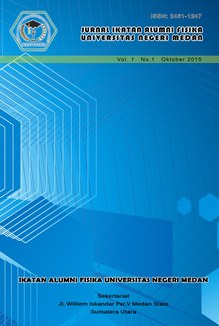PENGARUH METODE JUST-IN TIME TEACHING TERHADAP HASIL BELAJAR FISIKA
DOI:
https://doi.org/10.24114/jiaf.v1i1.2688Abstract
Penelitian ini bertujuan untuk mengetahui: (1) Hasil belajar mahasiswa yang diajar metode JiTT dan tanpa JiTT, (2) Hasil belajar Fisika mahasiswa yang mempunyai aktivitas belajar tinggi dan aktifitas belajar rendah. Dari hasil peneltian diperoleh metode JiTT dan tanpa JiTT memberikan hasil belajar yang berbeda. Dalam hal ini nilai gain rata-rata tes hasil belajar mahasiswa dengan metode JiTT sebesar 0,47 lebih tinggi dari nilai gain rata-rata hasil belajar mahasiswa tanpa JiTT sebesar 0,47. Aktivitas belajar tinggi dan aktivitas belajar rendah memberikan hasil belajar yang berbeda. Dalam hal ini gain rata-rata tes hasil belajar mahasiswa yang mempunyai aktivitas belajar tinggi 0,48 lebih tinggi dari pada gain rata-rata tes hasil belajar mahasiswa yang mempunyai aktivitas belajar rendah yakni sebesar 0,41. Tedapat interaksi antara model pembelajaran dan aktivitas belajar terhadap tes hasil belajar fisika sekolah pada mahasiswa.Kata Kunci: just in time teaching, hasil belajarReferences
Novak, G. 1993. http://jittdl.physics.iupui.edu/jitt/what.html.
Novak, G.1999. http://serc.carleton.edu/introgeo/justintime/index.html.
Novak, G. Gavrini, A. Cristian, W.1999. Just-in-Time Teaching: Blending Active Learning with Web Technology. http:// serc. carleton. Edu /resources /395.html
Sudarma, Teguh Febri. 2010. Pengaruh Model Just in Time Teaching (JiTT) terhadap hasil karya multimedia Jurusan Fisika.
Sudarma, Teguh Febri. 2013. Efek Model Pembelajaran Kooperatif Tipe STAD Berbasis Just in Time Teaching Terhadap Hasil Belajar Fisika. Jurnal Pendidikan Fisika Pascasarjana Unimed
Published
2015-10-11
Issue
Section
Articles
License
Authors who publish with this journal agree to the following terms:- Authors retain copyright and grant the journal right of first publication with the work simultaneously licensed under a Creative Commons Attribution License that allows others to share the work with an acknowledgement of the work's authorship and initial publication in this journal.
- Authors are able to enter into separate, additional contractual arrangements for the non-exclusive distribution of the journal's published version of the work (e.g., post it to an institutional repository or publish it in a book), with an acknowledgement of its initial publication in this journal.
- Authors are permitted and encouraged to post their work online (e.g., in institutional repositories or on their website) prior to and during the submission process, as it can lead to productive exchanges, as well as earlier and greater citation of published work (See The Effect of Open Access).

